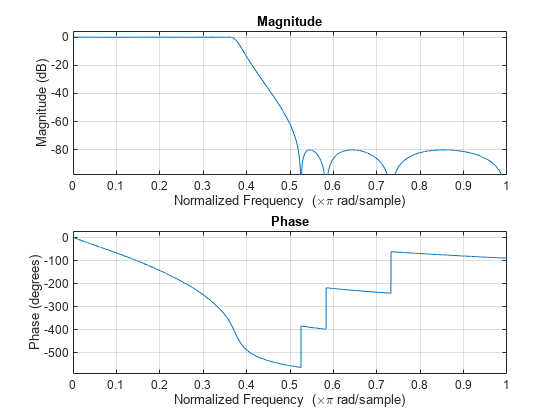dsp.LowpassFilter
FIR or IIR lowpass filter
Description
The dsp.LowpassFilter object independently filters each channel of the
input over time using the given design specifications. You can set the
FilterType property to 'FIR' or
'IIR' to implement the object as an FIR or an IIR lowpass filter.
When the FilterType property is set to 'FIR',
using this object is an alternative to using the firceqrip and
firgr functions with dsp.FIRFilter. The
dsp.LowpassFilter object condenses the two-step process into one. You can
use measure to verify that the design meets the prescribed specifications.
To filter each channel of your input:
Create the
dsp.LowpassFilterobject and set its properties.Call the object with arguments, as if it were a function.
To learn more about how System objects work, see What Are System Objects?
This object supports C/C++ code generation and SIMD code generation under certain conditions. This object also supports code generation for ARM® Cortex®-M and ARM Cortex-A processors. For more information, see Code Generation.
Creation
Description
LPF = dsp.LowpassFilter8 kHz, a stopband frequency of 12 kHz, a passband
ripple of 0.1 dB, and a stopband attenuation of 80
dB.
LPF = dsp.LowpassFilter(Name=Value)Name-Value pair arguments. Name is the
property name and Value is the corresponding value. For example,
PassbandFrequency=8000 sets the passband frequency specification of
the filter to 8000 Hz.
Properties
Usage
Syntax
Description
Input Arguments
Output Arguments
Object Functions
To use an object function, specify the
System object™ as the first input argument. For
example, to release system resources of a System object named obj, use
this syntax:
release(obj)
Examples
More About
Algorithms
References
[1] Shpak, D.J., and A. Antoniou. "A generalized Remez method for the design of FIR digital filters." IEEE® Transactions on Circuits and Systems. Vol. 37, Issue 2, Feb. 1990, pp. 161–174.
[2] Selesnick, I.W., and C. S. Burrus. "Exchange algorithms that complement the Parks-McClellan algorithm for linear-phase FIR filter design." IEEE Transactions on Circuits and Systems. Vol. 44, Issue 2, Feb. 1997, pp. 137–143.








